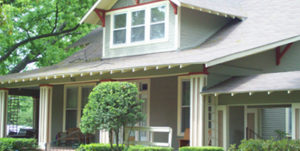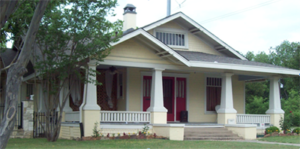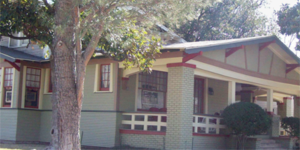ALPINE, TX.—A state board has approved the nomination of the Travis College Hill Addition to become Garland’s first entity listed on the prestigious United States National Register of Historic Places.
The State Board of Review of the Texas Historical Commission took the historic step Saturday, Sept. 17, at a meeting at the historic Holland Hotel in Alpine, Texas. The nomination now will be submitted to the National Park Service for final approval. Once the state completes and submits its paperwork, the National Parks Service will have 45 days to make the nomination official
The U.S. National Register represents the nation’s official list of properties deemed worthy of preservation. The listing imposes no restrictions on property owners.
Travis College Hill consists of a two-block area in historic downtown Garland on the 300-400 blocks of South 11th Street between Avenues B and D. The area was platted in 1913 and represents Garland’s most intact, extant enclave of Craftsman-influence bungalows. Several dwellings were built in the 1910s and 1920s.
On April 11, 2015, Travis College Hill received a Texas Historical Marker for its contributions to local and state history. The turn-of-the-last century Pace House has been relocated to a lot on 11th Street after its years of use as a city event facility. It has been returned to residential use.
Present at the Alpine meeting to represent Garland were 11th Street residents Louis and Kay Moore, who along with local a rchitect Scott Roberts were authors of the 47-page nomination. Others attending from Garland were Council Member Richard Aubin (District 5); Rebecca King, managing director of strategic initiatives for the city of Garland; and Robert A. Smith, president of the Garland Downtown Business Association.
rchitect Scott Roberts were authors of the 47-page nomination. Others attending from Garland were Council Member Richard Aubin (District 5); Rebecca King, managing director of strategic initiatives for the city of Garland; and Robert A. Smith, president of the Garland Downtown Business Association.
The Travis College Hill nomination was one of 15 Texas sites under consideration at the meeting of the SBR, which convenes three times a year in various Texas cities. Also approved was the application for the San Antonio Downtown and River Walk Historic District. Other nominations in the Metroplex included the Grand Lodge of the Colored Knights of Pythias, Texas, in Dallas and the Jennings-Vickery Historic District in Fort Worth.
Listing in the National Register provides national recognition of a property’s historical or architectural significance and assists in preserving the nation’s heritage. Buildings, sites, objects, structures, and districts are eligible for this designation if they are at least 50 years old (with rare  exceptions) and meet established criteria.
exceptions) and meet established criteria.
For the National Register application, 11th Street resident Kay Moore researched the hand-to-hand transfer of title from 1913 to the present for each of the 11 dwellings that contribute to the historical district. The 47 pages were replete with vignettes demonstrating how each home and its succession of owners reflected what was occurring not only in Garland at the time but also on the national scene. Influences of sweeping national events such as the Great Depression, World War II, and the economic recession of the 1980s were traced to their impact on the Travis College Hill homes and owners/dwellers.
Travis College Hill was nominated under the National Register’s Architecture criterion because it encompasses the best remaining grouping of early 20th-century bungalows within Garland. It also was nominated under the National Register’s Community Planning and Development criterion because “it presents a high degree of coherence and integrity and, in a broad sense, stands as a rare local example of a neighborhood that has managed to maintain its identity, despite intense redevelopment in surrounding neighborhoods and despite intense encroachments,” the nomination states.
“These historic Travis College Hill homes survive as an important link recalling a time in which Garland was a young city with a flourishing future beginning to unfold,” it states.
The Travis College Hill Addition was platted in 1913 by Dallasite developer Robert Orlando Travis, who purchased the acreage along Garland’s western fringes and carved it up into residential lots. Besides proximity to the downtown commercial area, churches and the town’s school, part of the allure to buyers was the proximity for the planned Interurban rail that was to run along Mewshaw on the southern border of the addition. The Interurban never materialized, but the neighborhood that developed concurrent to Interurban plans remains to this day.
Travis College Hill was one of the first new additions that had sprung up after the sparring communities of Duck Creek and Embree had settled their differences and become known as Garland.

